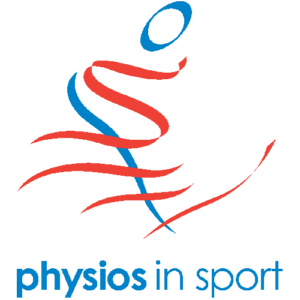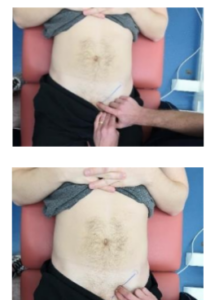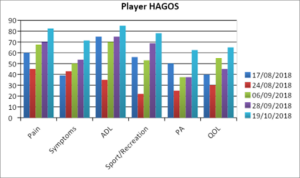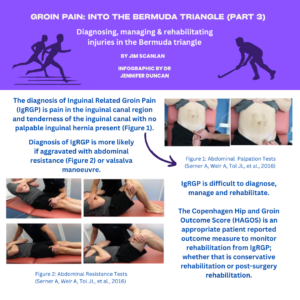Diagnosing, managing & rehabilitating injuries in the Bermuda Triangle
Keywords: Groin Pain; Inguinal; Rehabilitation

Introduction
This is the penultimate Blog in a series dealing with Groin Pain. Part 1, on Adductor Related Groin Pain (ARGP) and Part 2, Iliopsoas Related Groin Pain (IRGP), can be found here: Part 1; Part 2. This part deals with Inguinal Related Groin Pain (IgRGP).
Whilst the majority of groin related injuries in sport will be musculoskeletal in origin, clinicians should be cognisant of other potentially sinister pathologies such as cancer (1). A systematic review from Darren de et al., (2016) found that groin pain in athletes can be attributed to inguinal pathology in 10% of cases (2). Unfortunately, there is a dearth of high quality studies for the most efficacious management and rehabilitation for IgRGP (3).
Inguinal Related Groin Pain (IgRGP)
The diagnosis of IgRGP is pain in the inguinal canal region and tenderness of the inguinal canal (Figures 1 (12) and 2 (13)); no palpable inguinal hernia is present (4). Diagnosis of IgRGP is more likely if aggravated with abdominal resistance (Figure 3 (13)) or valsava manoeuvre (5); cough or sneeze. Inter-examiner reliability for diagnosis of IgRGP from clinical examination has been found to be poor with no one clinical test identified to confirm the diagnosis (6).In some instances, if conservative measures have failed then surgical treatment is an option. The Lloyd Release (7) being one such procedure. However, it would be prudent to exhaust all conservative measures before considering such invasive treatment. This could include, for example:
Sports Surgery Clinic Sports Medicine Groin Lab – Abdominal Series YouTube (8)
The principles of rehabilitation focused on inter-segmental control (Sports Surgery Clinic Sports Medicine, 2018) (9) has been associated with improved Hip and Groin Outcome Scores (HAGOS) (10) scores and good rates of pain-free return to sport across (11) a variety of groin pain diagnoses (4).
The Copenhagen Hip and Groin Outcome Score (HAGOS) (10) is an appropriate patient reported outcome measure (PROM) to monitor rehabilitation from IgRGP; whether that is conservative rehabilitation or post-surgery rehabilitation. It has substantial test-retest reliability with adequate measurement qualities for use with physically active, young to middle-aged patients with long-standing hip and/or groin pain.

Figure 1 Mean prevalence of palpation pain locations in athletes classified with IgRGP. *Scrotal Invagination (Vuckovic Z, Serner A, Heijboer WMP, et al., 2022) (12)

Figure 2 Abdominal Palpation Tests (Serner A, Weir A, Tol JL, et al., 2016) (13)

Figure 3 Abdominal Resistance Tests (Serner A, Weir A, Tol JL, et al., 2016) (13)
An exemplar series of HAGOS (10) scores for an apprentice footballer in a semi-professional environment is shown in Figure 4. Scores for each sub-scale range from 0 (extreme hip/groin problems) to 100 (no hip/groin problems) and can be easily calculated (14). Surgical intervention via Llyod release was used in this case following diagnosis of IgRGP (4) which was recalcitrant to conservative physiotherapy rehabilitation.

Figure 4 Player Hip and Groin Outcome Scores (HAGOS) (Thorborg K, Holmich P, Christensen R, et al., 2011) (10)
As can be seen from Figure 4, there was a reduction in scores across all sub-scales (except symptoms), indicating worsening of the condition, during the period 17/08/2018 to 24/08/2018. This was due to increased training load prior to surgical intervention at request of the surgeon to aid in confirmation of diagnosis prior to surgical intervention. Following surgery in late August 2018, the HAGOS (10) scores showed an increasing trend across the sub-scales indicating improvement in condition. Approximately six weeks post-surgery, the player had improved sufficiently to return to full training being available for selection. Objective testing of isometric adductor strength (via hand held dynamometer) was used in conjunction with HAGOS (10) scores to guide return to play decisions. This allowed for monitoring of potentially low isometric adductor strength, or between-limb strength asymmetry, with the former potentially putting players at increased risk of groin injury (15).
Conclusions
- IgRGP is difficult to diagnose, manage and rehabilitate.
- HAGOS is a valid tool to monitor IgRGP rehabilitation.

Acknowledgements: Thank you to the Association Chartered Physiotherapists in Sports and Exercise Medicine @physiosinsport and British Journal of Sports Medicine @BJSM_BMJ for their support in publishing this Blog.
Competing Interests: None
Jim Scanlan NHS Fife Advanced Practitioner Physiotherapist in General Practice
MSc; BSc (Hons); Pg Dip Ortho Med; Pg Dip Injection Therapy; IRMER Certified;
HCPC; MCSP; ACPSEM: Silver Accreditation. Twitter: @jim_physio
References
(1) National Institute for Health and Care Excellence (NICE) Guideline 12 (NG12) (2015). Suspected cancer: recognition and referral. Available at: https://www.nice.org.uk/guidance/ng12 (Accessed: 13 October 2023).
(2) Darren de SA, Holmich P, Philips M, et al., Athletic groin pain: a systematic review of surgical diagnoses, investigations and treatment. Br J Sports Med 2016;50(19):1181-86. DOI: http://dx.doi.org/10.1136/bjsports-2015-095137
(3) Serner A, van Eijck CH, Beumer, BR, et al., Study quality on groin injury management remains low: a systematic review on treatment of groin pain in athletes. Br J sports Med 2015;49(12):813-23. DOI: https://10.1136/bjsports-2014-094256
(4) Weir A, Brukner P, Delahunt E, et al. Doha agreement meeting on terminology and definitions in groin pain in athletes. Br J Sports Med 2015;49:768-74. DOI: https://doi:10.1136/bjsports-2015-094869
(5) Sirvastav S, Jamil RT and Zeltser, R. National Library of Medicine (2023). Valsalva Maneuver. Available at: https://www.ncbi.nlm.nih.gov/books/NBK537248/#:~:text=The%20Valsalva%20maneuver%20is%20forced,balloon%2C%20or%20playing%20the%20saxophone (Accessed: 13 October 2023).
(6) Heijboer WMP, Vuckovic Z, Weir A, et al., Clinical examination for athletes with inguinal-related groin pain: interexaminer reliability and prevalence of positive tests. Br J Sports Med Open 2023;9:e001498. DOI: https://10.1136/bmjsem-2022-001498
(7) Llyod DM. The Llyod Release Procedure (2023). Available at: https://www.lloydrelease.com/groin-pain/#:~:text=Upper%20groin%20pain%20is%20usually,usually%20elicits%20the%20painful%20symptoms. (Accessed: 13 October 2023).
(8) Sports Surgery Clinic Sports Medicine (2019) Sports Medicine Groin Lab – Abdominal Series. 28 September 2019. Available at:
https://www.youtube.com/watch?v=FP0NOkC2ISM&list=PL3DiW5Za63eWrCvHSEoUupOT4bDa8AveJ&index=8 (Accessed: 13 October 2023).
(9) Sports Surgery Clinic Sports Medicine (2018) Groin Lab -180 Cut Series. 17 September 2018. Available at: https://www.youtube.com/watch?v=P82-i7FZ-Fg&list=PL3DiW5Za63eWrCvHSEoUupOT4bDa8AveJ&index=8 (Accessed: 24 July 2023).
(10) Thorborg K, Holmich P, Christensen R, et al., The Copenhagen Hip and Groin Outcome Score (HAGOS): development and validation according to the COSMIN checklist. Br J Sports Med 2011;45(6):478-91. DOI: https://10.1136/bjsm.2010.080937
(11) King E, Franklyn-Miller A, Richter, C, et al., Clinical and biomechanical outcomes of rehabilitation targeting intersegmental control in athletic groin pain: prospective cohort of 205 patients. Br J Sports Med 2018;52:1054-62. DOI: https://10.1136/bjsports-2016-097089
(12) Vuckovic Z, Serner A, and Heijboer WMP, et al., Inguinal-related groin pain in athletes: a pathological potpourri. Br J Sports Med Open 2022;8: e001387. DOI: https://10.1136/bmjsem-2022-001387
(13) Serner A, Weir A, Tol, JL, et al., Can standardised clinical examination of athletes with acute groin injuries predict the presence and location of MRI findings? Br J Sports Med 2016;50(24):1541-47. DOI: https://10.1136/bjsports-2016-096290
(14) Ortho Tool Kit (2023). Free Online Copenhagen Hip and Groin Outcome Score (HAGOS) Calculator. Available at: https://orthotoolkit.com/hagos/ (Accessed 13 October 2023).
(15) Markovic G, Sarabon N, Pausic J. et al., Adductor Muscles Strength and Strength Asymmetry as Risk Factors for Groin Injuries among Professional Soccer Players: A Prospective Study Intl J Env Res and Pub Health 2020;17(14):4946. DOI: https://doi.org/10.3390/ijerph17144946